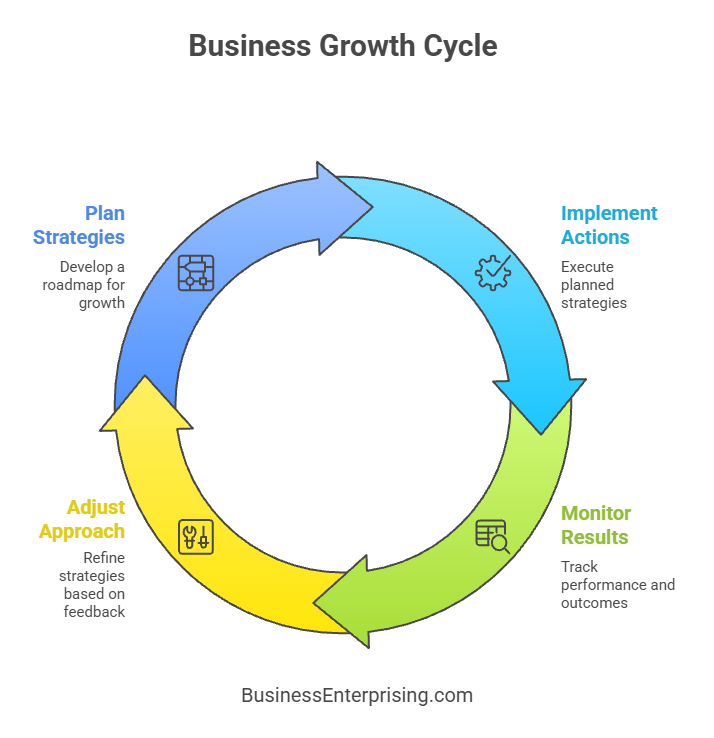
Additionally, growth strategies vary based on your goals and stage. Some companies want to scale fast. Others need steady progress with fewer risks. Therefore, it’s important to match the approach to your resources. You’ll waste less time and get better results. You may start by improving current operations before looking outside your core market.
Many business owners don’t lack ideas. The hard part is knowing which one to act on next. That’s why it helps to break growth into focused steps. You might need to sell more to current customers, launch a new offer, or move into a new area. Each option carries its own rewards and challenges. Therefore, it’s smart to look at several strategies before choosing one.
Additionally, you should review your numbers often. Growth should come with stronger cash flow and better margins. If it doesn’t, the strategy may need a second look. Tracking results helps you spot weak areas early and adjust faster. That habit can save you money and keep your business on track.
Planning your next move starts with clear thinking. These strategies are meant to give you useful direction and practical ideas. You’ll gain more control and make better decisions by taking small, consistent steps forward.
Market Penetration Tactics
Expanding your share of an existing market is one of the most practical business growth strategies. You don’t need to create a new product or reach a different audience. Instead, you focus on selling more to people already familiar with your brand. Many companies do this by refining their marketing approach. For example, you can improve how and where you advertise. Use clear messaging, better visuals, and precise targeting to reach more buyers.
Additionally, pricing can make a big difference. Small price reductions often increase volume without hurting margins too much. You can also offer time-limited promotions or bundled discounts. These help drive more frequent purchases and can move slower-selling items. However, be careful with discounts. If used too often, they can weaken your brand or train your customers to wait for sales.
Customer loyalty programs are another effective way to keep buyers engaged. These programs reward people for repeat purchases and referrals. Many customers will spend more if they know they’re earning points or future discounts. Therefore, you can use loyalty programs to increase order size and frequency. They also make customers less likely to try a competitor.
Improved customer service also plays a part. If people trust your support team and know they’ll get quick help, they’re more likely to buy again. Therefore, training your staff and responding fast to complaints can directly boost retention.
Finally, you should track the data. Look for what’s working and what’s not. By reviewing your performance regularly, you can adjust faster and avoid waste. Most successful businesses refine their strategies often. That habit, over time, leads to stronger results and steady growth.
Product or Service Diversification
Expanding your product or service line can help you grow faster. This approach lets you reach new customer groups or meet different needs. If you already have brand recognition, adding a new offer can build on that trust. It also gives customers more reasons to choose you over someone else. Therefore, diversification can boost both sales and customer loyalty.
However, this strategy comes with risks. If the new product flops, it can drain time and money. You might also confuse your existing customers. That confusion can weaken your brand if the new offer feels out of place. Additionally, if your team is stretched thin, quality can suffer. Therefore, before launching anything new, test the idea carefully and get feedback.
Start by asking what your customers need that you don’t currently offer. Then look at your resources. Make sure you can deliver consistently. Many companies start small with a new line or service. They watch how it performs before scaling it up. This approach lets you manage risk while staying flexible.
Product or service diversification works best when tied to a clear purpose. Maybe you want to reach a new income bracket. Or maybe you want to solve a related problem your customers already face. Either way, your messaging must be clear. Customers need to understand how the new offer fits with your existing brand. Used wisely, diversification can support long-term growth. It belongs among the more ambitious business growth strategies. Therefore, treat it like an investment. Plan carefully, watch results, and stay ready to adjust.
Strategic Partnerships and Alliances
Working with another business can help you grow faster and with fewer risks. Strategic partnerships and alliances give you access to new tools, audiences, and ideas. Instead of building everything on your own, you can share resources and expand your reach. Therefore, these relationships often improve your results without increasing overhead.
Additionally, partnerships can strengthen your value to customers. When you team up with someone who offers something you don’t, your business becomes more complete. For example, you might pair your product with a service that customers already use. This approach adds convenience for them and increases loyalty for you. It can also lead to higher sales without needing to expand your team.
However, choose your partners carefully. Your values and goals need to align. If one side underperforms, both can suffer. Therefore, take time to set clear terms, goals, and expectations. You should also communicate often and review results regularly.
Many small businesses use partnerships to compete with larger companies. Working together helps you share marketing costs or reach new markets. It also helps reduce risks tied to new ventures. For example, you might test a new product with a partner before rolling it out alone. That can give you feedback and reduce the chance of failure.
Used well, strategic partnerships are one of the smartest business growth strategies. They let you scale without taking on too much at once. Additionally, they open doors you might not reach on your own. When both sides win, the results can last long term.
Geographic Expansion
Expanding into a new geographic market can help your business grow when your current area becomes saturated. You may find untapped demand or lighter competition elsewhere. Therefore, geographic expansion is one of the more aggressive business growth strategies. When done right, it can drive steady revenue increases over time.
Domestic expansion often starts with nearby regions. These areas share customer habits and regulations, which makes the move less complex. However, you still need to study local buying behavior and pricing trends. A product that performs well in one city might not do as well in another. Additionally, your operations must scale to support new locations. That includes staffing, shipping, and marketing.
International growth offers even more potential. You can reach a wider audience and gain from currency shifts or lower production costs. However, the challenges are greater. You must handle foreign regulations, taxes, and sometimes language differences. Therefore, work with professionals who understand the region before investing too heavily.
Whether you expand locally or globally, your brand must remain consistent. Customers expect the same quality and service everywhere. Therefore, build systems that let you scale while keeping control. You might also need local partnerships to help with distribution or customer service.
Geographic expansion can push your business into its next phase. It forces you to improve systems and rethink logistics. However, many successful companies grow by entering new markets slowly and learning as they go. Keep costs lean early and adjust based on what you find.
Digital Transformation and Automation
Using digital tools and automation can help your business work faster and smarter. These systems reduce errors, lower costs, and save time. You can automate routine tasks like billing, inventory tracking, or customer emails. Therefore, your team spends more time on valuable work and less on repetition.
Additionally, digital platforms make it easier to track what’s working. With real-time data, you can spot problems early and respond quickly. That kind of visibility improves decisions and helps you grow with less guesswork. As part of broader business growth strategies, digital tools give you a clear advantage. They help you respond to changes without slowing down operations.
Artificial intelligence is another option worth exploring. It powers chatbots, helps with forecasting, and even improves customer targeting. AI tools can support your team without replacing them. They work in the background and speed up complex tasks. However, always test before rolling out any new tech fully. Poor setup can create more work instead of less.
Digital transformation also improves the customer experience. You can respond faster, reduce delays, and offer self-service options. Therefore, your customers feel more in control and more satisfied. As a result, retention increases and complaints go down.
Technology also supports scalability. As your business grows, your systems should grow with it. Therefore, pick tools that let you add users or features over time. That way, you won’t need to rebuild every few years. Digital tools can’t solve everything, but they make growth more manageable and more measurable.
Funding and Financial Scaling Strategies
Growing your business often requires outside funding. You may reach a point where internal cash flow no longer supports your goals. Therefore, knowing how to secure capital is a key part of your planning. Many owners explore venture capital, private equity, or traditional loans. Each option comes with benefits and tradeoffs.
Additionally, you should match your funding method to your growth stage. Startups may look to investors who offer more than money. These backers bring advice and connections. However, they often want equity in return. Established businesses may prefer loans or credit lines. That path keeps ownership intact while still supporting expansion.
Before raising capital, review your numbers. Lenders and investors will ask for clear financials and future projections. Therefore, track your revenue, margins, and cash flow closely. These metrics also help you avoid overextending. Growth that’s too fast can strain operations. Accurate data gives you a clearer view of what’s working and what’s not.
Financial scaling also means building systems that grow with you. You may need better accounting software or outside help with planning. Additionally, revisit your pricing and cost structure. Small changes can have a big impact on profits. Better margins give you more options and fewer funding needs.
Smart financial management supports long-term success. It keeps you in control and ready for new opportunities. Of all the business growth strategies available, financial scaling is the one that keeps everything else running smoothly. Therefore, take the time to understand your numbers and plan ahead.
Conclusion
Growth takes time, focus, and steady action. There is no perfect formula, but you can build a plan that fits your goals. Start with what your business needs most right now. Then choose the next step that gives you the best return.
Additionally, give yourself room to test and adjust. Not every effort will go as expected. However, consistent progress often beats large leaps. You don’t need to act on every idea at once. Instead, take one or two business growth strategies and put them into motion. Watch the results and stay flexible.
Each strategy you use should connect to a clear outcome. That could mean more sales, better retention, or stronger margins. Therefore, set targets before you begin. Without them, you may waste time or miss key changes. Use numbers to measure results, not guesses or opinions. You’ll make better decisions when the data speaks first.
Additionally, make sure your team is on board. Growth affects every part of your business. If people don’t understand the plan, progress slows down. Therefore, share your goals and give clear direction. When everyone pulls in the same direction, momentum builds faster.
Running a business is a long-term effort. Your choices today shape your results later. Therefore, treat growth as a habit, not a project. Keep learning, testing, and improving. When you stay focused, you give your business a better chance to succeed.



